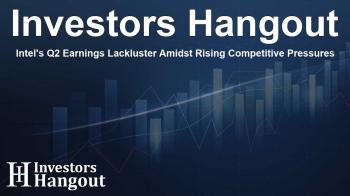Intel's Q2 Earnings Lackluster Amidst Rising Competitive Pressures

Intel Faces Setbacks After Disappointing Q2 Earnings Report
Intel Corporation (NASDAQ: INTC) is feeling the effects of a challenging quarter after posting disappointing financial results recently. The semiconductor leader reported an earnings per share of -$0.10, falling well short of expectations, missing analyst projections by 171.81%.
In premarket trading, shares are quoted at $21.20, a drop of $1.43 or 6.32% compared to the previous closing price of $22.63. This earnings miss has amplified concerns regarding Intel’s foundry business and broader operational issues, leaving investors questioning the effectiveness of the company’s turnaround strategy.
Impact of Q2 Earnings on Investor Confidence
The second quarter of 2025 proved to be challenging for Intel, showcasing an earnings per share significantly below anticipated figures. Many had expected Intel to break even, marking the -$0.10 loss as one of the starkest earnings misses in recent memory. This contrasts with earlier periods, such as Q4 2024 and Q1 2025, where the company outperformed expectations.
Nonetheless, the company did report quarterly revenue reaching $12.86 billion. However, it’s essential to note that an explicit comparison to analyst revenue expectations was not provided, clouding the overall understanding of financial health. Currently, the trailing twelve months earnings per share is recorded at -$4.77, highlighting ongoing financial difficulties as Intel navigates its renewed focus on recovery.
Leadership Under Scrutiny
With these disappointing results, scrutiny is now falling on CEO Pat Gelsinger’s direction. The semiconductor industry is rapidly changing, and questions arise about Intel's ability to effectively compete while facing obstacles, especially in high-growth sectors such as artificial intelligence and data center technology.
Scrutiny of Intel's Foundry Strategy
The challenges faced by Intel’s foundry business continue to raise alarms about the company’s long-term viability. Recent insights reveal that the foundry division is struggling to establish a foothold even as significant investments were made to bolster its capabilities.
This is particularly alarming in light of Intel's commitment to expanding its advanced manufacturing capacity within the United States as part of broader initiatives aimed at sustaining national competitiveness in chip manufacturing. Yet, the ongoing difficulties faced by the foundry division could lead to a major shift in strategy, forcing Intel to concentrate on its more traditional processor design and manufacturing areas.
Potential Implications of Foundry Exit
If Intel were to disengage from the foundry business, it would signal a notable change in its strategic course, which might lead to considerable asset write-downs. This thought raises concerns about relationships with governmental partners invested in Intel's domestic production efforts.
Market Reaction and Stock Performance
The stock has faced considerable volatility, underperforming when measured against both sector peers and the general market over the long term. Currently, shares are valued lower than the stock's 52-week range, where it fluctuated from $17.67 to $31.56.
Interestingly, although the stock has seen a year-to-date increase of 12.87%, this figure does not encapsulate the stock's struggles over the past year, wherein it has declined by 28.16%, contrasting sharply with an approximate 17.25% gain experienced by the S&P 500 during the same timeline.
Analysts' Perspectives on Future Performance
Investor sentiment towards Intel remains complex, with varying analyst price targets ranging from a low of $14.00 to a high of $28.30, suggesting that uncertainty clouds predictions of Intel's future. The current trading volume has substantially exceeded typical amounts, reflecting increased interest and possible institutional adjustments following the recent earnings report.
Moreover, comparisons with peers like NVIDIA and AMD, who have been simultaneously benefiting from the AI sector boom, further complicate Intel's market position. The company is dealing with undefined trailing price-to-earnings ratios due to recent losses, challenging the reliability of conventional valuation measures. The mix of execution obstacles and competitive pressures continues to challenge investor confidence, frustrating efforts to stabilize stock performance.
Frequently Asked Questions
What were the primary reasons for Intel's Q2 earnings miss?
Intel's Q2 earnings missed expectations due to a significant loss of -$0.10 per share, which raised concerns about its foundry strategy and broader operational challenges.
How is Intel's foundry business performing?
The foundry business is currently facing substantial challenges and may pose exit risks that could significantly impact the company’s strategy moving forward.
What is the current market sentiment towards Intel's stock?
Market sentiment towards Intel is mixed, characterized by volatility in pricing and underperformance relative to peers, amidst ongoing strategic uncertainties.
What steps is Intel taking to recover from these challenges?
Intel is focusing on enhancing its manufacturing capabilities while attempting to refine its strategic direction, especially regarding its competitive stance in the semiconductor sector.
How do analysts view Intel's future earnings potential?
Analysts have a range of opinions on Intel’s future earnings, reflected in a wide dispersion of price targets, indicating mixed confidence in the company's ability to recover and grow.
About The Author
Contact Caleb Price privately here. Or send an email with ATTN: Caleb Price as the subject to contact@investorshangout.com.
About Investors Hangout
Investors Hangout is a leading online stock forum for financial discussion and learning, offering a wide range of free tools and resources. It draws in traders of all levels, who exchange market knowledge, investigate trading tactics, and keep an eye on industry developments in real time. Featuring financial articles, stock message boards, quotes, charts, company profiles, and live news updates. Through cooperative learning and a wealth of informational resources, it helps users from novices creating their first portfolios to experts honing their techniques. Join Investors Hangout today: https://investorshangout.com/
The content of this article is based on factual, publicly available information and does not represent legal, financial, or investment advice. Investors Hangout does not offer financial advice, and the author is not a licensed financial advisor. Consult a qualified advisor before making any financial or investment decisions based on this article. This article should not be considered advice to purchase, sell, or hold any securities or other investments. If any of the material provided here is inaccurate, please contact us for corrections.

